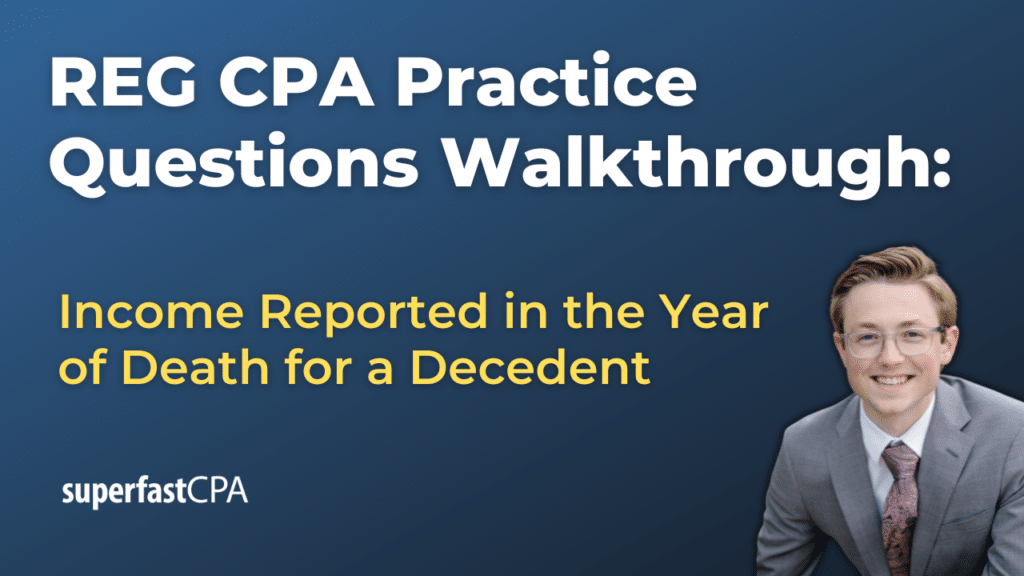In this video, we walk through 5 REG practice questions demonstrating how to calculate the income reported in the year of death for a decedent. These questions are from REG content area 4 on the AICPA CPA exam blueprints: Federal Taxation of Individuals.
The best way to use this video is to pause each time we get to a new question in the video, and then make your own attempt at the question before watching us go through it.
Also be sure to watch one of our free webinars on the 6 “key ingredients” to an extremely effective & efficient CPA study process here…
How to Calculate the Income Reported in the Year of Death for a Decedent
Calculating the income reported in the year of death for a decedent involves several steps, taking into account the various sources of income the decedent might have had up until their date of death, as well as specific income items known as Income in Respect of a Decedent (IRD).
Final Personal Income Tax Return
A final personal income tax return must be prepared for the year of the decedent’s death. This includes all income received from January 1 of the year of death up to the date of death. Income sources can include:
- Wages or salaries for work performed before the death.
- Investment income, such as interest, dividends, and capital gains earned up until the date of death.
- Business income if the decedent owned a business or was self-employed.
- Retirement income, including distributions from IRAs or 401(k)s, received before death.
Income in Respect of a Decedent (IRD)
IRD refers to amounts that were owed to the decedent at the time of death but had not yet been included in their taxable income. Since these amounts were not taxed before the decedent’s death, they must be included in the taxable income of the recipient, who could be the decedent’s estate or a beneficiary. Common examples of IRD include:
- Outstanding salary or commissions owed to the decedent.
- Deferred compensation benefits.
- Unpaid bonuses.
- Retirement account distributions that the decedent was entitled to but did not receive before death.
- Certain annuities and other deferred payment arrangements.
- Unpaid dividends and interest.
IRD is taxable to the recipient in the same manner it would have been taxable to the decedent if they had lived to receive it. However, the recipient may be entitled to a deduction for any estate taxes paid on the IRD items.
Filing Requirements
- Final Return for the Decedent: The executor or administrator of the estate is responsible for filing the final personal income tax return (Form 1040) for the decedent. This return will report the decedent’s income up to the date of death.
- Estate’s Income Tax Return: The estate may need to file its own income tax return (Form 1041, U.S. Income Tax Return for Estates and Trusts) if it earns income after the date of death. This includes income generated by the estate’s assets during the administration period.
- IRD Reporting: The recipient of IRD must report these amounts on their own tax return (for individuals, this is typically Form 1040). The specific reporting requirements depend on the nature of the IRD and the recipient’s tax situation.
Deductions and Credits
The final personal tax return can include deductions and credits the decedent was entitled to up to the date of death, such as medical expenses, charitable contributions, and personal exemptions. Additionally, beneficiaries or the estate may be able to claim a deduction for estate taxes paid on IRD amounts.
Example:
Alex passed away on July 20th. Before their passing, Alex had the following sources of income for the year:
- Wages: Alex was employed as a customer service representative and earned $20,000 up until the date of death.
- Interest Income: Alex had a savings account that generated $500 in interest income.
After Alex’s death:
Stock Dividends: Alex owned shares in a company that paid $300 in dividends, but these dividends were received after July 20th.
Calculation:
- Wages: The $20,000 earned from employment before Alex’s death will be included on the final personal income tax return.
- Interest Income: The $500 from the savings account, accrued before Alex’s death, will be included on the final personal income tax return.
- Stock Dividends (Received After Death): The $300 in dividends received after Alex’s death would not be included on Alex’s final personal income tax return. Instead, these dividends are considered Income in Respect of a Decedent (IRD) and would be reported on the tax return of the estate or the beneficiaries, depending on who is entitled to receive them.













